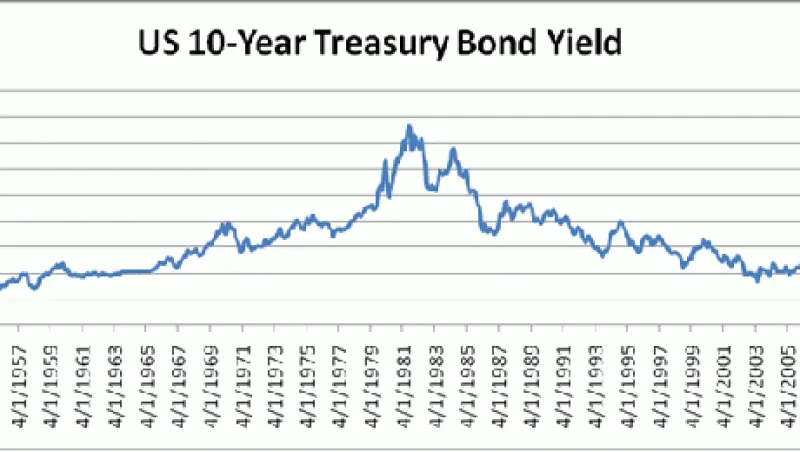IN 2005 THEN–Federal Reserve chairman Alan Greenspan mused about the “conundrum” of low long-term U.S. Treasury yields in the face of a rising federal funds rate. Today many analysts are again baffled by low bond yields, this time citing two different conundrums.
Bond yields could not possibly remain so low relative to equity earnings yields and dividend yields, people say. Nor could recent bond yields possibly make sense in light of current inflation levels, they say. But neither of these assertions holds water when examined with proper perspective. On the contrary, Treasury yields are likely to remain low for years, although brief rises are certainly possible. Moreover, new lows in Treasury yields probably still lie ahead.
Consider the first conundrum: the current relationship of Treasury yields to equity and dividend yields. In both the third and fourth quarters of 2011, the earnings yield on the Standard & Poor’s 500 Index was more than 2.5 times the composite long-term government bond yield, by far the biggest multiple in the past 50 years. And in the fourth quarter, the dividend yield on the S&P 500 (2.13 percent) was only barely below the composite long-term government bond yield (2.7 percent) — the narrowest gap in decades. These facts are cited as reasons that bonds have been overpriced.
Yet the complete historical record shows that the current relationship of earnings yields to Treasury bond yields is hardly unprecedented. The ratio has been far higher in the past and has stayed above current levels for long periods. The comparison of bond yields to dividend yields over the past 130 years paints a similar picture, with today’s bond yields appearing not all that unusual.
The return of the earnings-yield-to-Treasury-yield ratio to levels that existed before 1960 is highly consistent with a unique characteristic of the past four years: the reversal of U.S. private sector balance-sheet expansion. From the end of World War II through 2007, private sector balance sheets (both assets and liabilities) generally expanded faster than incomes, reflecting rising leverage and the accompanying inflation in asset values. As the asset appreciation came to be gradually embedded in expectations, investors demanded less current yield from equities relative to bonds.
Since 2008 debt has contracted and asset valuations have been on a secular decline. Investors’ priorities have shifted toward preserving capital and away from chasing asset appreciation. This shift is reflected in the low yield on Treasury Inflation-Protected Securities and in the high rental yield on real estate relative to government bond yields. Investors are highly averse to taking losses, let alone to paying a premium for prospective appreciation. It is hardly surprising that equity yields have risen sharply in relation to bond yields.
The second apparent conundrum cited by bond skeptics is that investors have been willing to accept a negative real return on Treasuries. In early 2012 the monthly average ten-year TIPS yield was negative for the first time ever, inciting cries that Treasury bonds (both TIPS and regular Treasuries) were in “bubble territory.” However, such low real yields are in fact not so surprising, and nominal yields are likely to remain depressed.
Consider the outlook for Treasury yields this way: From spring 2011 to early 2012, the decline in the ten-year Treasury nominal yield from 3.5 percent to 2 percent was driven primarily by increased demand for Treasuries as a safe asset, not by falling inflation expectations. Think of the nominal yield as being the sum of two components — the real yield and inflation expectations. Taking the TIPS yield as a rough proxy for the real yield, the decline in the real yield component accounted for more than two thirds of the total nominal yield decline.
Clearly, a major reason for the decline in real yields is that the pool of “safe” assets in the world has shrunk while the demand for them has broadly continued to grow. Central bank asset purchases and downgrades of structured securities and European sovereign debt together have eliminated a huge pool of safe assets.
Looking ahead, real yields appear likely to resist upward pressure. The pool of safe assets will remain shrunk. Although the perceived riskiness of European sovereign debt will vary somewhat, the taint on these formerly ironclad securities is unlikely to vanish for a long time.
Meanwhile, inflation expectations are likely to fall over the course of the next year. Disinflationary pressures in the economy — most notably, the downward pressure on wage inflation from high unemployment — will remain strong. Additionally, perceptions of economic strength are likely to weaken as 2012 progresses. • •
David Levy is chairman of the Jerome Levy Forecasting Center, a Mount Kisco, New York–based economic research and consulting firm.






